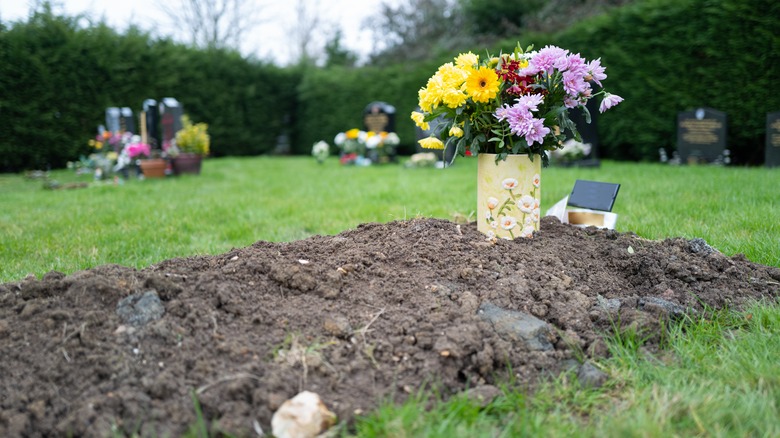How 1982 Murder Victim 'Princess Doe' Was Finally Identified 40 Years Later
On July 15, 1982, a gravedigger by the name of George Kise was working at the Cedar Ridge Cemetery located in Blairstown, New Jersey when he chanced upon a chain with a crucifix on the ground. Right by the chain was the dead body of a young, white female clothed in a red shirt and red-and-white skirt (via Office of the Prosecutor). Police were immediately called to the scene and upon further inspection, they discovered that the young woman wasn't wearing undergarments or footwear. Her location was in a wooded area leading to a stream in the northern part of the cemetery.
An autopsy of the woman was carried out the following day, and the results revealed that she died from blunt force trauma to the head and face. Her body was partially decomposed, and the injuries to her face were so severe that she was unrecognizable, as reported by CBS News. Investigators attempted to identify her through fingerprints, but police and national records failed to yield positive results.
The search for her identity
The investigators' main goal was to identify the murdered woman, but it was a difficult task. No clues regarding her identity were found at the scene, and she was not in any database that was checked. X-rays of her teeth and her fingerprints were kept for future comparison. According to the Office of the Prosecutor, authorities next sought help from the public. A composite sketch of what the victim would have looked like was circulated to the press in hopes that someone would be able to identify her. Despite their efforts, no one recognized her.
Authorities dubbed the unidentified young woman Princess Doe. She was between 14 and 18 years old, stood at 5 feet 2 inches, weighed 110 pounds, and had brown hair. There were no tattoos, birthmarks, or old scars found on her body (via Princess Doe). The autopsy couldn't pinpoint the exact time of death because of the hot weather and exposure to the elements, but it was estimated to be one to three weeks before her body was discovered.
Blairstown residents came together to bury Princess Doe
Months after Princess Doe's discovery, the residents of Blairstown decided that the unidentified woman found in their township needed a proper burial. They paid for her burial and grave marker with their own money, and the gravedigger who discovered Princess Doe, George Kise, was the one who dug her a grave, as reported by ATI. On her headstone was engraved, " Princess Doe / Missing from home / Dead among strangers / Remembered by all," followed by the date when she was found.
Investigators didn't stop trying to identify Princess Doe. As noted by the Office of the Prosecutor, Princess Doe was the very first unidentified person submitted to the National Crime Information Center database (NCIC), the FBI's index of missing persons, fugitives, criminal records, and other criminal justice information. Still, it would be more than two decades later until investigators get a promising lead in the case. Throughout the years, the residents of Blairstown never forgot Princess Doe and held memorials for the unnamed murder victim.
The confession of Arthur Kinlaw
In 2005, Arthur Kinlaw was serving his sentence a New York prison for two murder charges he was convicted of in 2000. Kinlaw was suspected of running a prostitution ring as well. According to the New York Times, Kinlaw wrote a letter to authorities five years into his sentence to confess to the murder of a woman that he committed in Blairstown, the township where Princess Doe was found. Investigators took a formal statement from him, and he also provided details about the crime that convinced authorities that he was, indeed, Princess Doe's murderer.
Despite the confession, Kinlaw couldn't be charged with the crime, as Princess Doe was still unidentified and the confession alone couldn't be used to verify what really happened, as noted by the Office of the Prosecutor. It would be another 17 years after Kinlaw's confession when investigators would finally be able to conclusively name Princess Doe.
Princess Doe was identified after 40 years
The process of identifying Princess Doe began in 2007. Her skeletal remains were tested and in 2021, Princess Doe's eyelash and tooth were given to Astrea Forensics for DNA extraction and analysis. Astrea Forensics is a company that specializes in genome sequencing from degraded remains. Its mission is to assist in genetic genealogy and law enforcement investigations to be able to solve cold cases. Her DNA profile was updated and submitted to Innovative Forensic Investigations, which created a genealogical profile from the DNA sample.
As reported by CBS News, Princess Doe was finally identified in April 2022 as Dawn Olanick, a 17-year-old from West Babylon, New York. Investigators were able to confirm the information with Olanick's brother, who said that his sister left home at 16 or 17 years old and had been missing since 1982. Olanick's sister also provided a DNA sample to compare with Princess Doe's, and based on the mitochondrial DNA profile, Princess Doe was confirmed to be the Dawn.
Arthur Kinlaw was charged with Princess Doe's murder
Almost two decades after his confession, authorities were finally able to issue a warrant of arrest for Arthur Kinlaw in the murder of Dawn Olanick. According to CBS News, Kinlaw attempted to lure Olanick into prostitution, but the girl refused and Kinlaw killed her. He then drove and left her body at the cemetery where she was eventually discovered by the gravedigger.
In a press conference, Olanick's family thanked the investigators who never stopped working on the case for 40 years until she was identified. Eric Kranz, one of the original investigators who worked on the case, said that it was a good feeling to finally give identity to the girl who was unknown for 40 years. Kranz was the one who coined the term Princess Doe to set her apart from all the other Jane Does. "It's very nice to know she has a name," Kranz stated at the press conference, as reported by Lehigh Valley Live.





